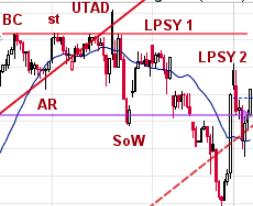Wyckoff Method Applied in the Intraday Timeframe
Market analysis involves various methods and techniques to understand and interpret price movements. Among these methodologies, the Wyckoff method has stood the test of time as a reliable approach for traders and investors. This article delves into the application of the Wyckoff method in the intraday timeframe, offering insights and strategies to navigate the dynamic nature of intraday trading.
Understanding the Wyckoff Method
The Wyckoff method, developed by Richard D. Wyckoff, focuses on analyzing the relationship between supply and demand to identify potential price movements. This method emphasizes studying price action, volume trends, and market sentiment to gauge the underlying forces driving the market. By interpreting the actions of large operators, or smart money, traders can anticipate future price movements and make informed trading decisions.
Intraday Trading and Wyckoff Method
Intraday trading involves buying and selling financial instruments within the same trading day. The fast-paced nature of intraday trading requires traders to make quick decisions based on short-term price movements. Applying the Wyckoff method in the intraday timeframe can provide traders with a structured approach to navigate the volatility and rapid price fluctuations that characterize intraday trading.
Key Principles of Wyckoff Method in Intraday Trading
1. Price and Volume Analysis: Intraday traders using the Wyckoff method focus on analyzing price and volume trends to identify potential entry and exit points. By observing price action in conjunction with volume patterns, traders can assess the strength of buying or selling pressure in the market.
2. Support and Resistance Levels: Identifying key support and resistance levels is essential in intraday trading. The Wyckoff method emphasizes the significance of these levels in determining potential price reversals or breakout opportunities. Traders can use this information to set stop-loss orders and profit targets effectively.
3. Market Phases: The Wyckoff method categorizes market movements into four phases: accumulation, markup, distribution, and markdown. Intraday traders can use these phases to interpret market dynamics and anticipate potential trend reversals or continuations.
4. Tape Reading: Tape reading involves analyzing the flow of trades and price movements in real-time. By closely monitoring the tape, intraday traders using the Wyckoff method can detect signs of buying or selling pressure and make informed trading decisions based on market sentiment.
Strategies for Intraday Trading with Wyckoff Method
1. Breakout Trading: Intraday traders can use the Wyckoff method to identify breakout opportunities when price surpasses key resistance levels. By waiting for confirmation of a breakout with increased volume and price momentum, traders can enter trades with higher probability of success.
2. Pullback Trading: Trading pullbacks within the context of the Wyckoff method can be a profitable strategy for intraday traders. By waiting for price to retrace to a key support level after a strong uptrend, traders can enter trades at favorable prices with tight stop-loss orders.
3. Volume Confirmation: Intraday traders using the Wyckoff method should pay close attention to volume confirmation when analyzing price movements. Sudden spikes in volume can indicate potential trend reversals or continuations, providing valuable insights for trading decisions.
Conclusion
Intraday trading requires a disciplined approach and a deep understanding of market dynamics. By applying the principles of the Wyckoff method in the intraday timeframe, traders can gain a competitive edge in navigating the fast-paced nature of intraday trading. By incorporating price and volume analysis, support and resistance levels, market phases, and tape reading techniques, traders can make informed trading decisions and capitalize on short-term price movements effectively.
